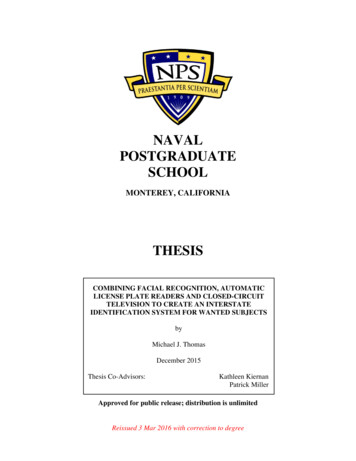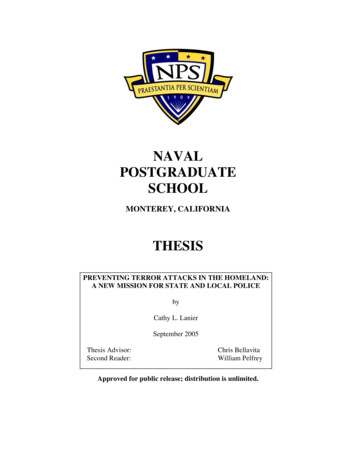
Transcription
liaecSpRrtoepNaval Postgraduate SchoolCenter forHomeland Defenseand SecurityEducation Report20111
Glen WoodburyDirectorCenter for Homeland Defense and SecurityColleagues,The 21st Century beganin earnest on themorning of September11, 2001.That day changed theway Americans viewsecurity, and how publicsafety professionals dotheir jobs. The NavalPostgraduate SchoolCenter for HomelandDefense and Securityembraced its role in thisnew era by creatingeducational programson the forefront of homeland security and giving thoseprograms to the nation.In January 2003, CHDS began offering the Master ofArts in Security Studies to a class of 14 students. Sincethat time, more than 460 of the nation’s most talentedhomeland security officials have participated in themaster’s degree program*. These alumni, in turn, sharethe concepts learned during their course of study withtheir home agencies, their colleagues and the emergingdiscipline of homeland security.Homeland security education is far from a staticendeavor. CHDS has been sensitive to evolving needsof this new discipline and its educational offerings reflectthat flexibility.Since its inception, the Center has added theExecutive Leaders Program, which caters to high-levelprofessionals in the private and public sectors whoreceive a graduate-style education in a less formalformat. More than 300 professionals have participated inthe program since it was established in 2006. In 2010,CHDS, in conjunction with the Department of HomelandSecurity, conducted its inaugural Fusion Center LeadersProgram to further development of these criticallyimportant information-sharing operations. The Universityand Agency Partnership Initiative shares CHDS’ stateof-the-art curriculum with more than 250 colleges anduniversities from across the country.CHDS education extends well beyond the brick-andmortar of the Naval Postgraduate School. More than 200Executive Education Seminars have been conducted*Figures for Master's and Executive Leaders programrepresent data through 2011 year’s end.IIfor top-level municipal and state executives, reachingmore than 7,200 officials in their own jurisdictions.Additional resources offered through the Center includethe Homeland Security Digital Library, the nation’spremier repository for homeland security documents,and Homeland Security Affairs, the nation’s first peerreviewed, digital journal in the field.However, programs and statistics only illustrate a fractionof the Center’s value. The true worth lies in the storieslived by our alumni every day. Our alumni are the changeagents of the homeland security profession. This can beseen by New York Fire Department Assistant Chief JoePfeifer’s work in establishing the department’s first Centerfor Terrorism and Disaster and Preparedness or EvelynSahli of Citizen and Immigration Services researchingportable DNA testing to verify kinship in immigrationcases.The Center would not be possible without the continuedsupport of our partners. We would like to give specialacknowledgement to the U.S. Department of HomelandSecurity, Department of Defense, Department of Justiceand the Naval Postgraduate School, institutions thatprovide oversight and sponsorship.Finally, we encourage you to visit our campus inMonterey, Calif., to view first-hand the resources we offerto protect our nation.Truly yours,Glen WoodburyInformation about the Center is available at:www.chds.usThe Nation's Homeland Security EducatorFor additional information about CHDS, ourprograms, or to arrange a visit, please contactHeather IssvoranDirector of Strategic Communications(831) 402-4672 (PST)hissvora@nps.edu
Naval Postgraduate SchoolCenter for Homeland Defense and SecurityEducation Report 201120Academic Programs01-2101Remember.Honor.Persevere.Master's Degree Program04Executive Leaders Program24Fusion Center LeadersProgram30Executive Education SeminarsConducted byMobile Education Teams32University and AgencyPartnership Initiative35Self-Study Courses38Educational ResourcesHomeland SecurityDigital Library41Homeland Security Affairs Journal42CHDS Faculty/Experts43www.CHDS.USWe willneverforget.The Center for Homeland Defense and SecurityAnnual Education Report 2011 Special Report waspublished in August 2011 by the Naval PostgraduateSchool Center for Homeland Defense and Security(CHDS) Monterey, California. Views expressed inthis publication do not necessarily represent theofficial policy or position of the Naval PostgraduateSchool, the Department of Homeland Security, theDepartment of Defense, CHDS, the CHDS alumnior faculty, or the U.S. Government.1
Overview of the Center for Homeland Defense and SecurityThe Naval Postgraduate School (NPS) Center for Homeland Defense and Security (CHDS or the Center) is the nation’shomeland security educator. CHDS was created by a unique partnership between Congress, the U.S. Department ofJustice and the U.S. Department of Defense on April 11, 2002, in response to the tragic and devastating September 11,2001, terrorist attacks. The Center’s creation was in part to answer the nation’s question, “How can we prevent futureattacks and, if there is another attack, how do we ensure that we are prepared to respond?” To this end, CHDS was giventhe mandate to:1) Educate and prepare a national cadre of local, state, tribal and federal leaders to collaborate acrossprofessional disciplines and levels of government to secure the nation’s homeland by developing new policies,strategies, and organizational arrangements to prevent and respond to future attacks;2) Begin to define through evidence-based research the emerging discipline of homeland security and thecurriculum components of graduate and executive-level homeland security education; and3) Facilitate the development of a national homeland security education system by using an “open source”model to develop programs, curriculum and educational tools and share these resources with other academicinstitutions and agencies to expedite their development of homeland security programs.Over the last nine years of its existence, the Center has consistently and rigorously evaluated its shared programs andresources to ensure the relevance of its curriculum to the national homeland security community. The growth of theCenter is directly related to the successful collaboration between agencies, universities and officials charged with thedevelopment of strategy and policy for homeland security.View of the Naval Postgraduate School campus in Monterey, California,location of the Center for Homeland Defense and Security.Center for Homeland Defense and Security Programs and Resources Since 2002, CHDS has provided a neutral educational forum where current and future homeland security leadersdevelop policies, strategies, programs, and organizational elements to counter terrorism and handle catastrophic events Through graduate-level coursework, seminars, and research, homeland security leaders gain analytic homeland securityexpertise while bridging gaps in interagency, intergovernmental, and civil-military cooperation Core programs sponsored by the U.S. Department of Homeland Security, National Preparedness Directorate, FEMA2
CHDS Programs and ResourcesHomeland Security Master’s Degree Program In January of 2003, this fully accredited 18-month program began to bring local, state, tribal and federal leaderstogether in a unique learning environment Participants are in-residence two weeks per quarter; remainder of coursework completed via network-based learning 150 students from diverse disciplines are enrolled in concurrent cohorts – law enforcement, fire, emergencymanagement, public health, etc.; cohorts graduate every six months; currently more than 460 alumni Participants complete a thesis on actual policy issues confronting their city, state, or sponsoring organization; thesesare being implemented by agencies around the nation to solve HS challengesExecutive Leaders Program (ELP) Four one-week seminars over nine months for senior level public and private sector officials; more than 300participants to date Participants acquire deeper understanding of current and emerging homeland security issues and public policydebates while strengthening working relationships across agencies and levels of governmentFusion Center Leaders Program (FCLP) Consists of a one-week, in-residence program; initiated in May 2010, with two cohorts a year Graduate level course examines key questions and issues facing fusion center leaders, their role in homeland securityand public safety, and the Information Sharing EnvironmentExecutive Education Seminars (EES) for Governors, Mayors and HS Leaders Half-day executive seminars, facilitated by Mobile Education Teams (METs) and subject matter experts, provide aneutral educational forum to explore, discuss and debate HS issues Topics are discussed in a roundtable format utilizing area specific interactive scenarios More than 200 seminars conducted, reaching more than 7,200 officialsUniversity and Agency Partnership Initiative (UAPI) - www.uapi.us CHDS offers its curriculum, learning technologies, and educational resources to more than 250 partners who alsoshare their curriculum and specialized expertise with CHDS and other UAPI partners “Multiplier effect” increases number and diversity of students with access to homeland security education nationallyHomeland Security Self-Study Courses Non-credit, online versions of the MA courses; available to professionals who wish to enhance their understanding ofkey concepts and require the flexibility of self-paced instructionHomeland Security Digital Library (HSDL) - www.hsdl.org Nation’s premier collection of HS policy and strategy related documents; supports local/state/tribal/federal analysis,decision-making, and academic research Full collection and special features are accessible to account holders; a portion of the collection is open to the public More than 20,000 unique visits per month, providing access to over 92,000 policy and strategy documentsHomeland Security Affairs Journal - www.hsaj.org Online academic journal publishing submissions from national experts Articles propose and debate strategies, policies, and organizational arrangements to strengthen homeland security3
CHDS Education ProgramsMaster of Arts ProgramOverview of the Master's Degree ProgramCurrent and/or rapidly advancing homeland security leaders from diverse disciplines, including law enforcement, fire,emergency management and public health, comprise the student body in the CHDS Master’s Degree Program. Theirdemanding jobs prevent most of these professionals from enrolling in traditional in-residence masters degree programs. Toaccommodate their time constraints, students are required to be in-residence only two weeks each quarter, a total of twelveweeks for the entire 18-month program, allowing students to continue fulfilling their job requirements while gaining valuableexpertise which benefits their profession, agency and/or organization. Students complete the remainder of their courseworkvia network-based learning. They also complete a thesis on an issue facing their city, state or organization. This programhas more than 460 alumni and over 150 current participants.The Master’s Degree ProgramThe Master of Arts program in Homeland Security and Defense at the Naval Postgraduate School was established in 2002,and classes began in January 2003. This rapid development, an anomaly in academe, was possible because of a needsassessment already completed and the willingness of the Naval Postgraduate School, a graduate-only institution with 33separate Master’s programs and 16 doctoral programs, to be adaptive and agile. The need for and original elements of thecurriculum were identified in 1999 through a lengthy, objective research process. The process produced the essence ofthe initial curriculum of that program. Fourteen highly qualified public safety administrators accepted the invitation to be theinaugural class. The curriculum has changed dramatically since the first cohort, and the master’s alumni will exceed 460*professionals by year end.Acceptance to this graduate program involves a competitive process that hinges on the academic credentials of applicants,their criticality to homeland security and their future impact. It should be no surprise that the graduates of this program areand have been essential to homeland security in their communities. What may be surprising is the time and effort thesepublic servants devoted to this program. Most of those accepted already hold graduate degrees; the reason they want toparticipate is the value of the essential information and capability they gain through this program. Their most importantobjective, based on pretest data, is the enhancement of the safety and security of their community.The combined collaborative efforts of the local, state, tribal and federal participants (civilian and military) have influenced thenation’s preparedness. Their impact has been evident in the development of the guiding documents and policy statementsat the local, state and federal level.*Figures for Master's and Executive Leaders program represent data through 2011 year’s end.4
Essence of the CurriculumThe essence of the curriculum is embodied in an element that is overarching – prepare homeland security leaders tooperate in an environment of extreme ambiguity. This element has been consistently rated as one of the most importantaspects of this graduate program. Other elements that have been at the top or close to the top of the importance of programor course objectives are: Communicate appropriately with other agencies and organizations to ensure the sharing of critical information duringand following a homeland security threat or incidentAbility to identify and build strategic relationships within your homeland security organization and across the homelandsecurity communityImprove efforts for collaboration, information-sharing, threat recognition, and target hardening between variousdisciplines.Table1 - CHDS Master’sNationalImpactTable:objectivesFederal (NonThese are the building blocks to improving the capability to work in anambiguousenvironment.Thelearningall DHS) JurisdThirty federal alumni and current participants represent the governmeemphasize critical thinking around homeland security issues associated with: Mapping the environment of homeland securityPreventing and mitigating threats through interventionTable1 - CHDSMaster’sNational riskImpactTable: Federal(NonDHS) Jurisdiction OnlyThirty federal alumni and current participants represent the government.Preparing for response to threatsStrategic planning and developing organizational imperatives in homeland securityPolicy analysis and research methods capabilitiesThe program is developed on the foundation of the upper levels of the "Taxonomy of Learning Objectives in the CognitiveDomain." Taught by internationally renowned faculty and practitioners, all of whom are experts in their field of enquiry, theparticipant’s exposure to instruction and literature, stimulating cross-disciplinary discussions, is unmatched in academe.If the effects of this high-level, graduate seminar environment can be measured through grades, the median grade pointaverage for the last alumni class, across all courses, exceeds 3.8 on the 0.0 to 4.0 scale.The most important outcome of this graduate program is the development of a cadre of homeland security professionalsaround the country. The alumi of this program facilitate this organizational learning process and sustainable organizationallearning occurs when organizations have sponsored multiple graduates. More than 90 percent of the agencies sponsoring aparticipant in this program have supported subsequent applicants, though some have not been invited to participate due toTable 2 - CHDS Master’s National Impact Table: DHS Jurisdiction Othe strong competition from other more qualified applicants.One hundred DHS alumni and current participants represent the agency and itsTable 1 - CHDS Master's National Impact Table:Table 2 - CHDS Master's National Impact Table:Federal (Non DHS) Government OfficialsDHS Government OfficialsTable 2 - CHDS Master’s National Impact Table: DHS Jurisdiction OnlyMorethan100DHSparticipantsalumni ble 1 - CHDSMaster’s National30ImpactTable:Federaland(NoncurrentDHS) JurisdictionOnlyOne hundred DHS alumni and currentrepresentthe agencyand its components.represent the agency and its componentsThirty federalalumni and currentparticipantsrepresent the government.participantsrepresentthe governmentHDS Master’s National Impact Table: Federal (Non DHS) Jurisdiction Onlyhirty federal alumni and current participants represent the government.Table 2 - CHDS Master’s National Impact Table: DHS Jurisdiction OnlyOne hundred DHS alumni and current participants represent the agency and its components.ble 2 - CHDS Master’s National Impact Table: DHS Jurisdiction Onlyd DHS alumni and current participants represent the agency and its components.5
Table 2.1 CHDS Master’s National Impact Map: State Government OfficialsAlumni and current participants work in 39 states and one territory.6
Table 3 – CHDS Master’s National Impact Table: Local OfficialsMore than 200 local alumni and current participants represent nearly 150 local jurisdictions.Akron Police DeptCity of DallasAlameda CountyEmergency MgtServicesLocal Agencies Represented by Alumni & Current ParticipantsDouglas CountyNE Sheriff's DeptLong Beach CAPolice DeptCity Of DelrayBeach FL FireRescueFire Dept of NewYorkAnaheim MemorialMedical CenterCity of EastPoint GA FireFort Worth FireDeptArlington County FireDeptCity of FresnoCAFrederick MDCounty Sheriff'sOfficeLos AngelesCountyBioterrorismPreparednessProgramLos AngelesCounty Sheriff'sDeptLos Angeles FireDeptArlington CountyOffice of EmergencyMgtArlington (TX) PoliceDeptCity of MesaAZFremont CA FireDeptLos Angeles PoliceDeptNew York CityPolice DeptSaint Paul MNPolice DeptGlendale AZ FireDeptLos AngelesSheriff's DeptNorwalk OHPolice DeptSalem OR PoliceDeptGreenwood COVillage PoliceHillsborough CACounty Sheriff'sOfficeLove Field AirportHouston AirportSystemManagingDirector'sOffice/City ofPhiladelphiaManchester NHFire DeptOak Creek WIFire DeptOak Creek WIPolice DeptBeckley WV FireDeptCity ofMonterey CAPolice DeptCity of OrangeCA Fire DeptCity ofPompanoBeach FL FireRescueCity of SanDiegoBoston EmergencyMgt Services (EMS)City of SeattleFire DeptIndependence MOPolice DeptMemphis TNPolice DeptOffice of the CityAdministrator DCBoston Police DeptCity ofWaukesha WIPolice DeptClevelandDivision ofPoliceCoastal HealthDistrictIndianapolis PoliceDeptMenlo Park CAPolice DeptInglewood PoliceDeptD.C. MetropolitanWater DistrictOrland IL FireProtectionDistrictPasadena PoliceDeptSan Diego PoliceDeptSan FranciscoEMS &Emergency OPsSectionSan FranciscoOffice of ES &HSSan MateoCounty Sheriff'sArea Office ofES & HSSan MateoPolice DeptIsanti County MNOffice ofEmergency MgtJackson CountyFL Emergency MgtJacksonville FLFire & RescueMiami-Dade FireRescue DeptPhiladelphia LawDeptSeattle Fire DeptVentura CountySheriff's DeptPhiladelphiaPolice DeptPhoenix PoliceDeptSeattle PoliceDeptSedgwick KSCounty Fire DeptVentura PoliceDeptVirginia BeachPolice DeptJefferson CountyTXMilwaukee WaterWorksMobile County ALEmergency MgtAgencyMontclair NJ PoliceDeptMonterey CountyCA Health DeptSEPTA PA(AMTRAK)Transit PoliceSetauket NY FireDeptVolusia CountySheriff's OfficeKansas City MOPolice DeptKern County CAEmergencyMedical ServicesDept.Kern County CAEnvironmentalHealthLake CumberlandKY District HealthDeptMontgomeryCounty MD FireRescue ServicePierce CountyDept ofEmergency MgtPinal CountyDivision of PublicHealthPlano TexasSioux City IAPolice DeptWarfare PolicyBranch DCMontgomeryCounty MD PoliceDeptNaperville CAPolice DeptPort Authority ofNew York & NewJerseyRaleigh PoliceDeptSt. Clair CountyMI HSWest HartfordCT Fire DeptLas Vegas MetroPoliceNassau County NYDept of HealthRamsey CountyMNEM & HSSunnyvale CADept of PublicSafetyAustin Fire DeptBarren River DistrictHealth DeptCenterville OH PoliceDeptCentral Jackson MOCounty FireProtection DistrictCherry Hill NJ FireDeptChicago Fire DeptChicago Office ofEmergency Mgt &CommunicationsChicago Police DeptCincinnati Fire DeptCity of Aurora COColumbus OHDivision of FireConcord NHFire DeptContra CostaCA Sheriff'sOfficeD.C.MetropolitanPolice DeptDallas FortWorthInternationalAirportD.C. FEMSCity of ChicagoOffice of theCorporation CounselDelmar FireDeptCity of Chicago, Deptof AviationDenver PoliceDeptNassau CountyNY Office ofEmergency MgtNassau CountyNY Police DeptReno PoliceDeptSunnyvale CAPublic SafetyRiverside CAPolice DeptSyracuse PoliceDeptNew Windsor NYPoliceSacramentoMetropolitan FireDistrictSacramentoPolice DeptTampa FireRescueNew York CityOffice ofEmergency MgtOakland CA FireDeptScottsdale AZFire DeptGreaterClevelandRegional TransitAuthority TransitPoliceThe Univ ofTexas HoustonPolice DeptToledo Fire &RescueTucson Fire DeptTulsa Fire DeptTulsa PoliceDeptUnified FireAuthority ofGreater SaltLakeUnion CountyOffice ofEmergency MgtUpper Merion PAFire & RescueWalled Lake MIFire DeptSt. Paul Dept ofFire & SafetyServices7
The majority of participants in this graduate program represent the state and local levels of government. These public safetyadministrators are dedicated to the safety and security of more than 184 million citizens of their jurisdictions throughout theUnited States. These citizens are safer as a result of DHS' dedication to this program.Relevance of the Program to Homeland Security PolicyThe first National Strategy for Homeland Security, published December 2001, made clear prevention of threats was thehighest priority of the federal enterprise. Prevention has long been the highest priority of public safety agencies such as lawenforcement, fire and public health. Prevention and mitigation became the emphasis of the graduate program, not in thesense that participants were educated to employ prevention tactics but to pursue the goals of preventing attacks and reducingvulnerability. In other words, protect the “Whole Community” from emerging, developing and recurring threats, disasters andattacks. The second National Strategy for Homeland Security in 2007, stated clearly “requirements and capabilities withinthe planning phase of our system also must place particular emphasis on training and education so that homeland securityprofession als not only acquire the specific functional skills that are needed to successfully execute operational plans but alsounderstand the broader strategic context in which these plans will be executed” (p. 45). That strategy went on to describehomeland security education as an “investment in human capital.”The current doctrinal document, the National Security Strategy, published in 2010, makes clear that under the “Whole ofGovernment” approach, a key, perhaps the key element, in improving capabilities at all levels of government is “adapting theeducation and training of national security professionals to equip them to meet modern challenges.”Relevance of Program to National Initiatives“Adapting the education and training of national security professionals to equip them to meet modern challenges” is whatthis program has done since 2003, and continues to do through an adaptive education program addressing the most criticalelements of homeland security. Each of these elements are measured and reassessed with each cohort and at the end ofeach program of study to be certain they are the most relevant, most valuable learning objectives for homeland security andpublic safety leaders. As the importance of objectives changes, the curriculum changes to meet the new, emerging needs.The measurement of knowledge and capability gained through this program shows that, among this already sophisticatedgroup of leaders, the gains were 90.63%, averaged across all alumni since the first cohort. This means that for these 460alumni, knowledge associated with homeland security issues, strategies and research has almost doubled.Relevance of the Program to the “Whole Community” of Homeland SecuritySince its inception in 2003, this graduate program has invited only the most highly qualified public section safety and securityofficials to participate. While no discipline-specific admission goals exist, the proportion of accepted participants has beenroughly the same proportion of applicants’ disciplines. These participants, and their disciplines, best represent the homelandsecurity community: 8State and Local Law EnforcementU.S. Department of Homeland SecurityState and Local Fire and EMS ServiceState and Local Emergency Management and Homeland SecurityU.S. Department of Defense MilitaryState and Local Public HealthU.S. Department of Justice, Federal Bureau of InvestigationNational Guard Officers in Title 32 Status (State)Other Disciplines at All Tiers of Government25%18%16%8%9%7%3.5%2%11.5%
Impact of the CHDS Master's Degree ProgramThe impact of the CHDS Master's Degree Program is manifested in numerous ways. After nine years, many ideas,collaborative projects and theses have moved from the CHDS classroom to implementation in local, state, tribal and federalorganizations and agencies around the country. The Center strives to show the practical application of the innovativeideas resulting from student course work and projects and make them available to benefit the national homeland securitycommunity. The theses required to graduate from the Master's Degree Program address issues and concerns of activehomeland security professionals. Research in addition to post graduate fellowships, collaborative efforts and projects haveaffected legislation, created programs, increased readiness and encouraged further collaboration between local, state,tribal, federal and military agencies.The following articles highlight the accomplishments of just a few of the students who have graduated from the Master'sDegree Program.Education Into Practice, Research to Real WorldLeft to right: Special Agent Jeffrey Jones, Lt.Tracy Frazzano, Cmdr.Cheryl Wade and Lt. Col. Duke PirakStudent CIP Project Reflected in National Legislation“As a group, the research presented that we have reduced our level of air protections since 9/11 andhaven't taken steps to update our analytics to support what we are protecting and how we are doing it.The overall conclusion that we reached is that our resources are far from optimized.”Tucked into legislation signed into law earlier this year is arequirement for NORAD to work with the National Guard inevaluating the best use of the nation’s air defense to protectpeople and infrastructure.That language, which appeared in the 2011 NationalDefense Authorization Act, stems in part from concernsraised in a report by four students in the CriticalInfrastructure Vulnerability Analysis and Protection (CIP)course at the Naval Postgraduate School Center forHomeland Defense and Security. President Barack Obamasigned the legislation on January 7, 2011.As part of a course project, the CHDS student teamexamined how the Department of Defense assessesrisk and decides which assets to protect in the realm ofhomeland air defense, according to Lt. Col. Duke Pirak ofthe Oregon Air National Guard.“We uncovered what we think are some severe flaws in theirlogic and strategy,” Pirak said.The study goes to the underlying purpose of the course –Police Lieutenant Tracy Frazzanobecause not everything can be protected all the time, howdo agencies determine which assets are most critical andprotection-worthy?The course teaches how to apply modeling to assessvulnerabilities and build protection strategy.Pirak conducted the study with Lt. Tracy Frazzano ofthe Montclair (N.J.) Police Department; Jeffrey Jones,Supervisory Special Agent with the Federal Bureau ofInvestigation; and, Cmdr. Cheryl Wade of the VenturaCounty (Calif.) Sheriff’s Department.This study found shortcomings in current decision-makingregarding which population centers and which nodes ofinfrastructure, (such as energy or water) to protect.“As we uncovered how that was done, it was largely an adhoc effort,” Pirak said. “Because we have limited resources,it wasn’t the most efficient way to cover the most importantthings.”The four students applied a CIP modeling method to9
analyze the nation’s air defense scheme.Among the study’s recommendations: Develop comprehensive modeling to determine themost critical cross sector and interdependent nodes inorder to develop an optimal allocation strategy. Improve communications between the Department ofDefense and the Department of Homeland Security tofoster collaboration between the two entities. Drive strategic planning on this issue through alinked Quadrennial Defense Review and QuadrennialHomeland Security Review.“The ultimate goal is to remove emotion and politics outof this and come up with something that is informed byscience,” Pirak said.The study found that when deciding on equally sizedpopulation centers, one may have critical infrastructurenodes that were not being factored in to the decision.Additionally, the study called for more emphasis on threatassessment to consider events that would be devastating,yet unlikely, compared with more realistic concerns.“We suggest re-examining the nature of threat; where is itwe are really vulnerable?” Pirak noted.To reach its conclusion, each team member worked on aportion of the analysis.For example, Frazzano researched petroleum reserves anddistribution and their effects on transportation, defense andthe economy. She concluded that oil should be viewed in abroader context with other nodes.“As a group, the research presented that we have reducedour level of air protections since 9/11 and haven't takensteps to update our analytics to support what we areprotecting and how we are doing it,” she sa
their jobs. The Naval Postgraduate School Center for Homeland Defense and Security embraced its role in this new era by creating educational programs on the forefront of homeland security and giving those programs to the nation. In January 2003, CHDS began offering the Master of Arts in Security Studies to a class of 14 students. Since










